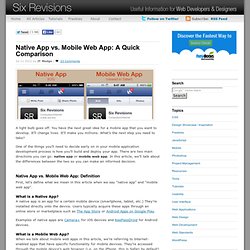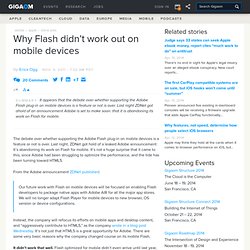

Twin Cities Startup Week: Panel of Minnesota's most successful Kic... Rethinking Mobile First. I wrote the Mobile First Web Second blog post a few years ago.

In that post, I talked about apps that were designed to be used on mobile primarily with the web as a companion. There have been a number of startups that have taken that approach and done well with it. Most notably Instagram, and also our portfolio company Foursquare. It has become a bit of a orthodoxy among the consumer social startup crowd to do mobile first and web second.
But is it the right thing to do? Vibhu makes some excellent points: All in all, mobile service apps turn out to be a horrible place to close viral loops and win at the retention game. And You have an entirely different onboarding story on the web. I use my phone more than anything else. Vibhu also takes a stance against the ad-supported, privacy challenged, free consumer app world. But I don't want to focus on business model in this post. But just because something is hard doesn't mean you shouldn't try to do it. Mobile 3.0 arrives: How Qualcomm just showed us the future of the cell phone (and why iPhone sucks for this new contextual age) The world just changed yesterday.

You probably didn’t notice. But I guarantee strategists at Apple, Facebook, Amazon, Microsoft, and Google did. What happened? Qualcomm shipped a new contextual awareness platform for cell phones. Gimbal. Native App vs. Mobile Web App: A Quick Comparison. A light bulb goes off.

The Future Isn't About Mobile; It's About Mobility - David Armano. By David Armano | 8:03 AM July 18, 2012 While the globe grapples with uncertain economic realities, “mobile” appears to be gold.

Facebook is expected to announce their uniquely targeted mobile advertising model before the end of the month. Entering iPhone Era: Marking Time in Mobile. UPDATE: There is now a full iPhone market projection with regional and quarterly breakdowns of the numbers, to show what Apple needs to sell to get to 10 M by end of 2008.

It is entitled Crunching Numbers for iPhone Ever since my January keynote on handset design at the big annual 3G event in Tokyo I've mentioned the iPhone in every public presentation. Mary Meeker Explains the Mobile Monetization Challenge - Liz Gannes - D10. Looming over the Internet industry is the mismatch between the growth in mobile usage and mobile monetization.

Most recently, it was the risk factor that helped take down Facebook’s ill-fated IPO roadshow, when the company warned at the last minute publicly (and perhaps more emphatically privately) that mobile monetization really wasn’t keeping pace. So it’s quite topical that today at D10, Kleiner Perkins Caufield & Byers venture capitalist and former Wall Street analyst Mary Meeker is delivering one of her famed Internet trends presentations by depicting the opportunity for mobile advertising. Here’s how Meeker describes it; there are a lot of stats in here, but they actually tell a rather smooth narrative: There are 1.1 billion global mobile 3G subscribers, which is 37 percent growth but just 18 percent penetration.
That’s compared to 2.3 billion global Internet users, with growth of just 8 percent from last year. One-Third of U.S. High School Students Now Own an iPhone. Piper Jaffray analyst Gene Munster today issued a report on his firm's latest semi-annual survey of U.S. teenagers, the 23rd such survey in the firm's history.

The results of the extensive survey of 5,600 U.S. high school students show that 34% of surveyed students now own an iPhone, an all-time high in the survey and double the percentage seen just a year ago. Furthermore, 40% of surveyed students indicated that they intend to purchase an iPhone within the next six months. Piper Jaffray ascribes the boom in iPhone use among students to new low-cost options from Apple. Apple and AT&T lowered the price of the iPhone 3GS to $49 back in January 2011, dropping it to free on-contract with the introduction of the iPhone 4S late last year. Disruptions: Wearing Your Computer on Your Sleeve. Adrian Dennis/Agence France-Presse — Getty ImagesInstead of going through life staring into a mobile device, people one day may be able to wear a computer.

Less Than 10% Of The Web In 2012 Is Mobile Ready. Mobile’s overall share of Web traffic in the United States has increased to about 9% (according to StatCounter) which is also the same percentage of Quantcast’s Top Million sites that are deemed ready for mobile in 2012 according to data from the Mongoose Metrics Data Series.

Since there wasn’t the same data pull last year, it could be compared loosely to data from Brand Anymore in late 2010, which determined that of 7,000 retail websites only 4.8% were mobile ready – a nearly doubling of the Web’s mobile readiness in a year. In the Mongoose Metrics data set, 118,000 of the 1,000,000 sites could not be crawled for a variety of reasons, resulting in approximately 882,000 sites that could be used for this data. Why Flash didn’t work out on mobile devices. The debate over whether supporting the Adobe Flash plug-in on mobile devices is a feature or not is over.

Last night, ZDNet got hold of a leaked Adobe announcement: It’s abandoning its work on Flash for mobile. It’s not a huge surprise that it came to this, since Adobe had been struggling to optimize the performance, and the tide has been turning toward HTML5. From the Adobe announcement ZDNet published: Our future work with Flash on mobile devices will be focused on enabling Flash developers to package native apps with Adobe AIR for all the major app stores.
We will no longer adapt Flash Player for mobile devices to new browser, OS version or device configurations. Instead, the company will refocus its efforts on mobile apps and desktop content, and “aggressively contribute to HTML5,” as the company wrote in a blog post Wednesday.